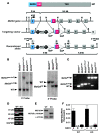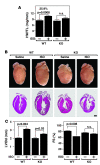The MEF2D transcription factor mediates stress-dependent cardiac remodeling in mice
- PMID: 18079970
- PMCID: PMC2129240
- DOI: 10.1172/JCI33255
The MEF2D transcription factor mediates stress-dependent cardiac remodeling in mice
Abstract
The adult heart responds to excessive neurohumoral signaling and workload by a pathological growth response characterized by hypertrophy of cardiomyocytes and activation of a fetal program of cardiac gene expression. These responses culminate in diminished pump function, ventricular dilatation, wall thinning, and fibrosis, and can result in sudden death. Myocyte enhancer factor-2 (MEF2) transcription factors serve as targets of the signaling pathways that drive pathological cardiac remodeling, but the requirement for MEF2 factors in the progression of heart disease in vivo has not been determined. MEF2A and MEF2D are the primary MEF2 factors expressed in the adult heart. To specifically determine the role of MEF2D in pathological cardiac remodeling, we generated mice with a conditional MEF2D allele. MEF2D-null mice were viable, but were resistant to cardiac hypertrophy, fetal gene activation, and fibrosis in response to pressure overload and beta-chronic adrenergic stimulation. Furthermore, we show in a transgenic mouse model that forced overexpression of MEF2D was sufficient to drive the fetal gene program and pathological remodeling of the heart. These results reveal a unique and important function for MEF2D in stress-dependent cardiac growth and reprogramming of gene expression in the adult heart.
Figures






Similar articles
-
Modulation of angiotensin II-mediated cardiac remodeling by the MEF2A target gene Xirp2.Circ Res. 2010 Mar 19;106(5):952-60. doi: 10.1161/CIRCRESAHA.109.209007. Epub 2010 Jan 21. Circ Res. 2010. PMID: 20093629 Free PMC article.
-
Adiponectin is required for cardiac MEF2 activation during pressure overload induced hypertrophy.J Mol Cell Cardiol. 2015 Sep;86:102-9. doi: 10.1016/j.yjmcc.2015.06.020. Epub 2015 Jul 19. J Mol Cell Cardiol. 2015. PMID: 26196305
-
Myocyte enhancer factors 2A and 2C induce dilated cardiomyopathy in transgenic mice.J Biol Chem. 2006 Apr 7;281(14):9152-62. doi: 10.1074/jbc.M510217200. Epub 2006 Feb 9. J Biol Chem. 2006. PMID: 16469744
-
MEF2 in cardiac hypertrophy in response to hypertension.Trends Cardiovasc Med. 2023 May;33(4):204-212. doi: 10.1016/j.tcm.2022.01.002. Epub 2022 Jan 11. Trends Cardiovasc Med. 2023. PMID: 35026393 Review.
-
A-kinase anchoring proteins: molecular regulators of the cardiac stress response.Biochim Biophys Acta. 2013 Apr;1833(4):901-8. doi: 10.1016/j.bbamcr.2012.07.014. Epub 2012 Aug 4. Biochim Biophys Acta. 2013. PMID: 22889610 Review.
Cited by
-
Genomic Binding Patterns of Forkhead Box Protein O1 Reveal Its Unique Role in Cardiac Hypertrophy.Circulation. 2020 Sep;142(9):882-898. doi: 10.1161/CIRCULATIONAHA.120.046356. Epub 2020 Jul 9. Circulation. 2020. PMID: 32640834 Free PMC article.
-
Transcriptional Regulation of Postnatal Cardiomyocyte Maturation and Regeneration.Int J Mol Sci. 2021 Mar 23;22(6):3288. doi: 10.3390/ijms22063288. Int J Mol Sci. 2021. PMID: 33807107 Free PMC article. Review.
-
The Molecular and Biological Function of MEF2D in Leukemia.Adv Exp Med Biol. 2024;1459:379-403. doi: 10.1007/978-3-031-62731-6_17. Adv Exp Med Biol. 2024. PMID: 39017853 Review.
-
Physiological Responses to Swimming-Induced Exercise in the Adult Zebrafish Regenerating Heart.Front Physiol. 2018 Oct 1;9:1362. doi: 10.3389/fphys.2018.01362. eCollection 2018. Front Physiol. 2018. PMID: 30327615 Free PMC article.
-
Hadp1, a newly identified pleckstrin homology domain protein, is required for cardiac contractility in zebrafish.Dis Model Mech. 2011 Sep;4(5):607-21. doi: 10.1242/dmm.002204. Epub 2011 May 31. Dis Model Mech. 2011. PMID: 21628396 Free PMC article.
References
-
- Czubryt M.P., Olson E.N. Balancing contractility and energy production: the role of myocyte enhancer factor 2 (MEF2) in cardiac hypertrophy. Recent Prog. Horm. Res. 2004;59:105–124. - PubMed
-
- Frey N., Katus H.A., Olson E.N., Hill J.A. Hypertrophy of the heart: a new therapeutic target? Circulation. 2004;109:1580–1589. - PubMed
-
- Frey N., Olson E.N. Cardiac hypertrophy: the good, the bad, and the ugly. Annu. Rev. Physiol. 2003;65:45–79. - PubMed
-
- Backs J., Olson E.N. Control of cardiac growth by histone acetylation/deacetylation. Circ. Res. 2006;98:15–24. - PubMed
Publication types
MeSH terms
Substances
LinkOut - more resources
Full Text Sources
Other Literature Sources
Molecular Biology Databases

